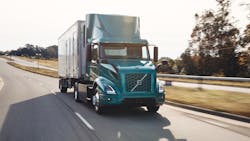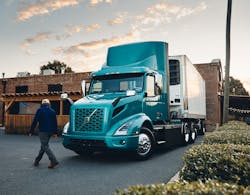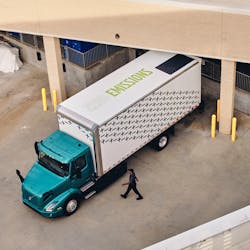Volvo sets VNR Electric production for early 2021
Designed for local and regional delivery fleets, Volvo Trucks North America (VTNA) has announced the official commercial introduction and sale of its first battery-electric Class 8 truck for the North American market.
The Volvo VNR Electric truck model, designed for fleet applications and drive cycles with local and regional distribution ranges, including food and beverage and pick-up and delivery routes, has a scheduled production start of early 2021. The truck will be manufactured at Volvo’s New River Valley assembly plant in Dublin, Va.
“In order to advance electromobility, Volvo Trucks is investing in the development and introduction of the technology here in North America,” explained Brett Pope, VTNA director of electric vehicles, during a Dec. 3 virtual press conference. “The pace of the transition will depend upon many variables, such as incentives to encourage adoption, access to charging infrastructure, and segment application coverage.”
In 2019, the OEM began its Volvo LIGHTS (Low Impact Green Heavy Transport Solutions) project in California to develop a blueprint designed to successfully introduce battery-electric trucks and equipment into the market at scale. The project helped Volvo obtain real-world feedback from customers testing the VNR Electric’s capabilities.
“Planning is absolutely essential to the success of this platform, as well as government incentives. The establishment of charging infrastructure and close collaboration is needed between all stakeholders throughout the process,” Pope said. “As an OEM, we have gained important information on how to prepare for production of the truck. With every mile driven, we are learning more about what it takes for the implementation and scaling of electromobility in the transportation industry.”
Peter Voorhoeve, president of VTNA, credited the LIGHTS project as the OEM’s opportunity to thoroughly learn and test the VNR Electric. Over the course of the project, Volvo worked with 14 partners to analyze ways to educate and train technicians to service electric vehicles, and worked with infrastructure providers, dealers, and two fleets — Dependable Highway Express and NFI — to make its Class 8 electric concept a reality.
“We got a really good view of the end-to-end impact of a zero-emission transport solution,” Voorhoeve said. “We learned a lot — and we are, by the way, still learning — from that project. It definitely has helped us to come out with the commercialization of our VNR Electric.”
Getting to know the VNR Electric
The VNR Electric shares comparable agility, visibility, and safety performance to the current diesel-powered VNR, John Moore, senior product manager of electric vehicles, pointed out. The safety criteria and features found in the Volvo VNR model, including in the construction of the cab and chassis, are also retained in the VNR Electric. The VNR includes active safety features, such as Volvo Active Driver Assist and Lane Departure Warning. However, the electric model offers drivers a different human-machine interface, quieter operation, and a smoother, fatigue-reducing ride overall.
“This is a big change, but then it is not,” Voorhoeve said of driving the VNR Electric compared to its diesel counterpart. “The driving to a very large extent is similar. Then, of course, moving to electromobility is a big change for our customers and for the transport system, but we have done our homework. We have done the LIGHTS project, worked together with different partners, and we looked at all the end-to-end aspects in the LIGHTS project.”
The VNR Electric’s 264-kW lithium-ion batteries, which charge up to 80% within 70 minutes, have an operating range of up to 150 miles based on the truck’s configuration. Regenerative braking can increase range by returning up to 15% of power back into the battery, depending on the duty cycle, Moore added.
The electric driveline is rated at 455 hp, generating up to 4,051 lb.-ft. of torque. The VNR Electric features a two-speed Volvo I-Shift transmission, and models are offered in three configurations: A single-axle straight truck with a gross vehicle weight rating of 33,200 lbs. and two tractor configurations — a 4x2 with a 66,000-lb. gross combination weight rating (GCWR) and a 6x2 with an up-to 82,000-lb. GCWR in specific applications.
Service coverage and financing options
From its LIGHTS project, Volvo learned just how critical it will be to help dealers and fleet customers navigate the transition to electric vehicles. Volvo is preparing its dealer network with the parts, service and tools, and training needed to service, maintain and monitor the VNR Electric trucks.
Magnus Koeck, vice president of marketing and brand management for VTNA , pointed out that zero-emission vehicle incentives offered in states like California and New York will likely drive the focus and sales of electric vehicles.
“The truck is not for everyone at this point,” Koeck explained. “It is for pick up, delivery, urban and regional areas — that’s really where the focus is for the time being, but that will change over time.”
Volvo is also offering financing and insurance solutions through Volvo Financial Services (VFS). VFS will provide dealer financing options, including floorplan for stock or pre-sold units, along with financing solutions for on-site charging stations.
Furthermore, the VNR Electric is covered by Volvo’s uptime promise, including remote diagnostics and a suite of connectivity services specific to energy management and battery performance. The OEM’s new Volvo Gold Contract service offering is a consultative approach that includes scheduled and preventive maintenance, towing, and vehicle repair, including the vehicle’s lithium-ion batteries and electromobility system.
“We have to act like consultants in some respect to match the right application with the customer and to get dealers up to speed to support the new product,” explained Mark Curri, senior vice president of uptime and customer support at VTNA .
A mixed future
Moving ahead with hydrogen fuel cell, Volvo Group and Daimler Truck AG recently signed a binding agreement for a joint venture to develop, produce and commercialize fuel cell systems for use in heavy-duty trucks. The aim of both partners is “to help the world take a major step towards climate-neutral and sustainable transportation by 2050.”
And although the two OEMs are still competitors and will release different products, working to develop the technology together will ultimately expedite the rollout of fuel cell technology for the commercial vehicle market.
“We believe that hydrogen fuel cell is another alternative fuel source that we will see happening in the future,” Voorhoeve surmised. “What we see now is that, in say 10 years to come, you will see not just one solution. We will continue to see diesel trucks, we will see a rapid increase of electric trucks on the road, and we will see fuel cell trucks that will mostly be in long haul and heavy haul. With electric, we will eventually see more in local and regional distribution for delivery and pickup, for instance. We will also see natural gas. But fuel cell is absolutely part of the solution going forward.”
About the Author

Cristina Commendatore
Cristina Commendatore is a past FleetOwner editor-in-chief. She wrote for the publication from 2015 to 2023.



